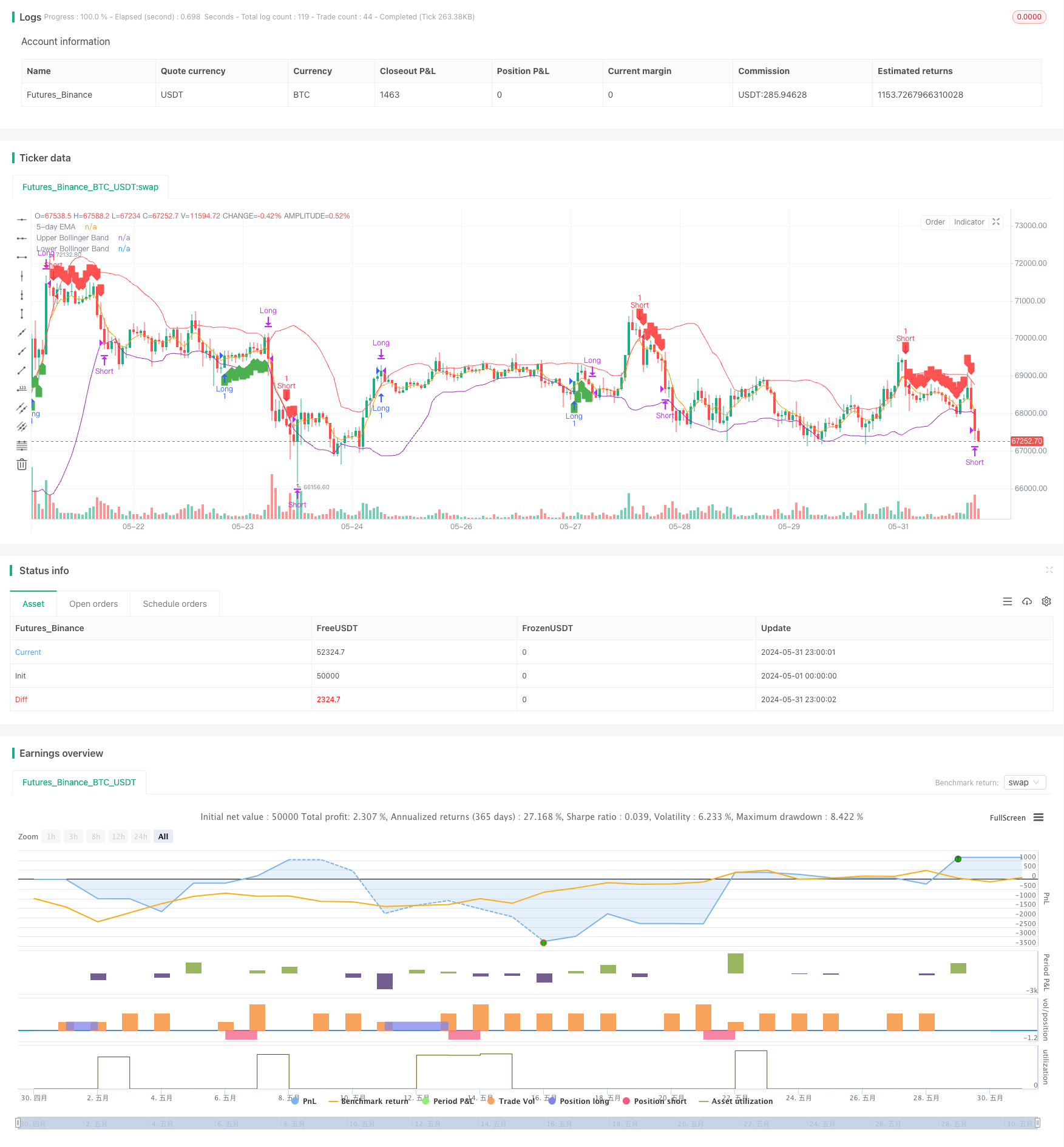EMA与布林带突破策略
Author: ChaoZhang, Date: 2024-06-03 16:23:06Tags: EMABB

概述
该策略使用5日指数移动平均线(EMA)和布林带(BB)来识别市场的潜在交易机会。当价格突破布林带上轨或下轨,并满足特定条件时,策略会产生买入或卖出信号。该策略旨在捕捉市场的显著价格波动,同时使用止损和目标价位来管理风险和最大化收益。
策略原理
该策略的核心是利用5日EMA和布林带来判断市场趋势和波动性。当价格突破布林带上轨,并在上一根K线高于5日EMA时,策略会产生卖出信号。相反地,当价格突破布林带下轨,并在上一根K线低于5日EMA时,策略会产生买入信号。这种方法可以帮助识别潜在的趋势反转或突破点。
一旦进场交易,策略会设置止损位和目标价位。止损位置于进场价格的相反方向,用于限制潜在损失。目标价位则是根据固定点数(如1000点)来计算的,以锁定预期收益。如果价格触及止损位或目标价位,该策略将平仓退出交易。
策略优势
- 同时利用EMA和布林带,可以更全面地评估市场趋势和波动性。
- 明确的进场条件有助于识别高概率的交易机会。
- 设置止损和目标价位,可以有效管理风险和锁定利润。
- 策略逻辑清晰,易于理解和实现。
策略风险
- 市场波动性增大时,布林带可能会产生频繁的交易信号,导致过度交易和手续费增加。
- 在震荡市或趋势不明朗时,该策略可能会产生错误信号,导致亏损。
- 固定的止损和目标价位可能无法适应不同的市场条件,限制了策略的灵活性。
策略优化方向
- 考虑使用自适应的止损和目标价位,根据市场波动性和趋势强度动态调整,以提高策略的适应性。
- 引入其他技术指标或信号过滤机制,如相对强弱指数(RSI)或平均真实波幅(ATR),以确认趋势和减少假信号。
- 对参数进行优化,如调整EMA的周期、布林带的标准差倍数等,以适应不同的市场特征和交易品种。
总结
EMA与布林带突破策略利用了两个常用的技术指标,旨在捕捉市场的显著价格波动。该策略具有明确的进场条件、风险管理措施和盈利目标,易于理解和实施。然而,策略的表现可能受到市场波动性和趋势不明朗的影响。通过引入自适应参数、信号过滤机制和参数优化,可以进一步提升策略的稳健性和盈利能力。
/*backtest
start: 2024-05-01 00:00:00
end: 2024-05-31 23:59:59
period: 1h
basePeriod: 15m
exchanges: [{"eid":"Futures_Binance","currency":"BTC_USDT"}]
*/
//@version=5
strategy("Nifty Bank Strategy", overlay=true)
// Parameters
lengthEMA = 5
lengthBB = 20
multBB = 1.5
targetPoints = 1000
// Calculate 5-day EMA
ema5 = ta.ema(close, lengthEMA)
// Calculate Bollinger Bands (length 20, multiplier 1.5)
basis = ta.sma(close, lengthBB)
dev = multBB * ta.stdev(close, lengthBB)
upperBB = basis + dev
lowerBB = basis - dev
// Define strategy variables
var float entryPrice = na
var float stopLoss = na
var float targetPrice = na
var bool inTrade = false
var bool isLong = false
var float triggerHigh = na
var float triggerLow = na
var float triggerClose = na
if not inTrade
// Short Entry Trigger Condition
if low > ema5 and low > upperBB and high > upperBB
triggerLow := low
triggerHigh := high
triggerClose := close
label.new(bar_index, high, "Waiting for short trigger", color=color.yellow)
// Long Entry Trigger Condition
else if high < ema5 and high < lowerBB and low < lowerBB
triggerHigh := high
triggerLow := low
triggerClose := close
label.new(bar_index, low, "Waiting for long trigger", color=color.yellow)
// Check for Short Entry
if not inTrade and na(triggerClose) == false and close < triggerClose
if low < triggerLow
entryPrice := close
stopLoss := triggerHigh
targetPrice := entryPrice - targetPoints
strategy.entry("Short", strategy.short)
label.new(bar_index, high, "Short", color=color.red, style=label.style_label_down)
inTrade := true
isLong := false
triggerLow := na
triggerHigh := na
triggerClose := na
// Check for Long Entry
if not inTrade and na(triggerClose) == false and close > triggerClose
if high > triggerHigh
entryPrice := close
stopLoss := triggerLow
targetPrice := entryPrice + targetPoints
strategy.entry("Long", strategy.long)
label.new(bar_index, low, "Long", color=color.green, style=label.style_label_up)
inTrade := true
isLong := true
triggerLow := na
triggerHigh := na
triggerClose := na
// Manage Short Trade
if inTrade and not isLong
if high >= stopLoss
strategy.close("Short", comment="SL Hit")
label.new(bar_index, high, "SL Hit", color=color.red, style=label.style_label_down)
inTrade := false
else if low <= targetPrice
strategy.close("Short", comment="Target Hit")
label.new(bar_index, low, "Target Hit", color=color.green, style=label.style_label_up)
inTrade := false
// Manage Long Trade
if inTrade and isLong
if low <= stopLoss
strategy.close("Long", comment="SL Hit")
label.new(bar_index, low, "SL Hit", color=color.red, style=label.style_label_down)
inTrade := false
else if high >= targetPrice
strategy.close("Long", comment="Target Hit")
label.new(bar_index, high, "Target Hit", color=color.green, style=label.style_label_up)
inTrade := false
// Plotting
plot(ema5, color=color.orange, title="5-day EMA")
plot(upperBB, color=color.red, title="Upper Bollinger Band")
plot(lowerBB, color=color.purple, title="Lower Bollinger Band")
// Plot trade entry and exit points
plotshape(series=inTrade and isLong ? entryPrice : na, location=location.belowbar, color=color.green, style=shape.labelup, title="Buy Signal")
plotshape(series=inTrade and not isLong ? entryPrice : na, location=location.abovebar, color=color.red, style=shape.labeldown, title="Sell Signal")
相关内容
- 多重指标趋势突破量化交易策略
- 布林带与指数移动平均结合交易策略
- EMA交叉与布林带双重入场策略:结合趋势跟踪与波动突破的量化交易系统
- 基于多重技术指标的均值回归趋势跟踪策略
- 动态风险管理的均线交叉与布林带策略
- 多重订单突破趋势跟踪策略
- 多重因子反转趋势交易策略
- 均值回归型布林带美元成本平均投资策略
- MACD BB 波段突破策略
- 波林格带和EMA趋势跟踪策略
更多内容
- 动态时间框架高低点突破策略
- 动态趋势跟踪策略
- 趋势过滤与异常退出的平滑移动平均止损止盈策略
- MACD与R:R比率日内限制收敛策略
- 星光移动平均交叉策略
- 百分比阈值量化交易策略
- 基于双均线交叉的移动平均线策略
- MACD与Supertrend组合策略
- 基于量价信号和烛台模式的买卖策略
- SMA趋势跟踪策略
- 基于CDC行动区的ATR止盈止损交易机器人策略
- 基于连续K线动态网格自适应均线动态止损策略
- 移动平均线交叉策略
- 趋势跟随与动量过滤相结合的交易策略
- RSI与线性回归通道交易策略
- 双重Vegas通道波动性调整SuperTrend量化交易策略
- EMA与RSI交叉策略
- 移动平均聚合动量云策略
- 双均线交叉止盈止损策略
- TEMA双均线交叉策略